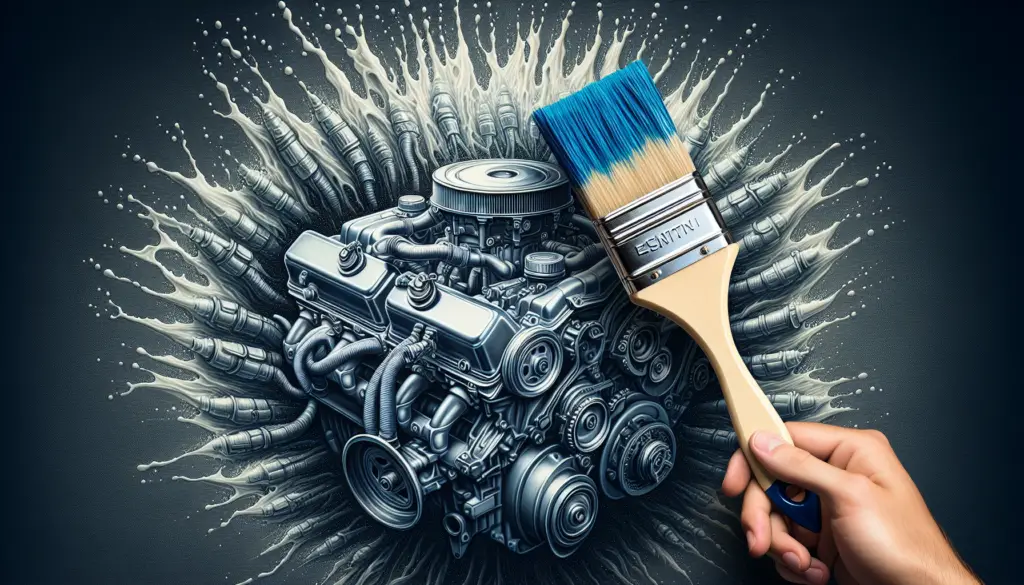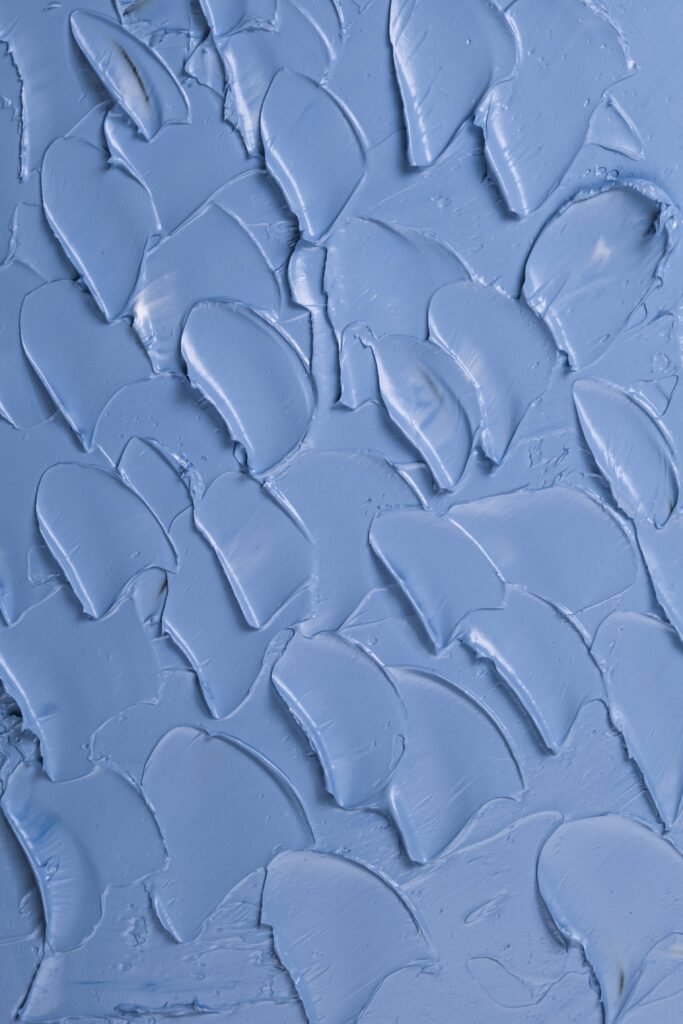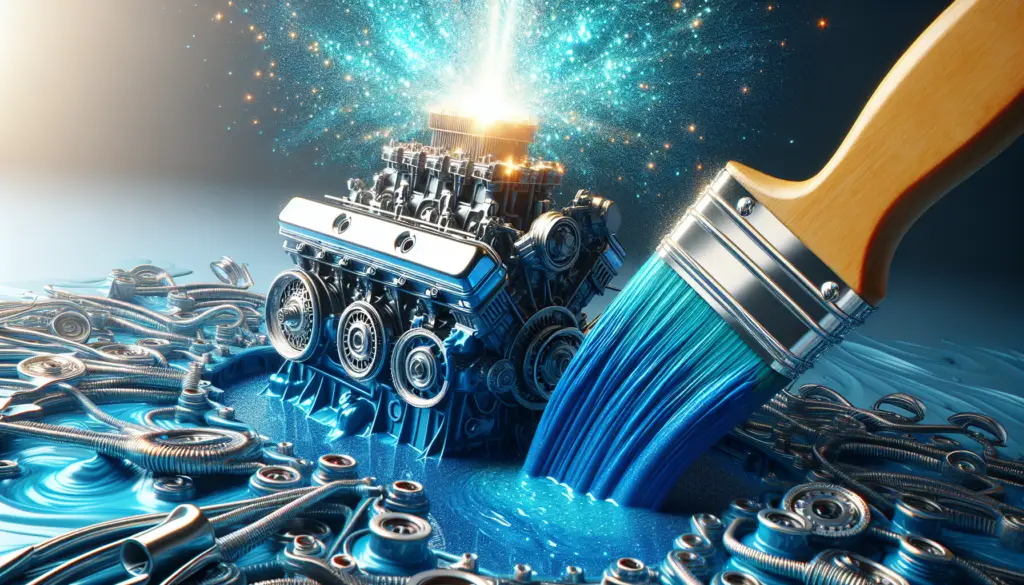So, you’ve decided it’s time to give your boat engine a fresh new look. Whether you’re looking to enhance its appearance or extend its lifespan, painting your boat engine can be a rewarding and cost-effective project. In this DIY guide, we’ll take you through the step-by-step process of painting your boat engine, from preparation to final touches. With a little patience and the right materials, you’ll have a sleek and vibrant engine that’s ready to sail the seas in style.

Preparation
Cleaning the engine
Before you begin the painting process, it is essential to start with a clean engine. Remove any dirt, grease, or debris that may be present on the surface. Use a degreaser or engine cleaner and a brush to scrub away any stubborn grime. Rinse off the cleaning solution thoroughly and allow the engine to dry completely before moving on to the next step.
Removing old paint
If your boat engine already has a layer of paint on it, you’ll need to remove it before applying a new coat. Start by using a chemical paint stripper or a pressure washer to soften and loosen the old paint. Once the paint starts to bubble up or peel off, use a scraper or wire brush to remove it completely. Be cautious when using harsh chemicals, and always follow the manufacturer’s instructions for safety.
Sanding the surface
After removing the old paint, the engine’s surface may be rough or uneven. To ensure a smooth and even coat of paint, sand the surface with fine-grit sandpaper. Sanding will help create a better bond between the paint and the engine surface. Be thorough but gentle during this step to avoid causing any damage to the engine. Once you finish sanding, make sure to remove any dust or debris with a clean cloth or air compressor.
Choosing the Right Paint
Types of paint for boat engines
Choosing the right paint for your boat engine is crucial to achieve a durable and long-lasting finish. Look for paints specifically designed for marine applications, as they are formulated to withstand the harsh conditions of the water, including exposure to saltwater and UV rays. Marine-grade paints are also resistant to corrosion and provide excellent adhesion.
High-temperature paint options
Boat engines can reach high temperatures, so it’s important to select a paint that can withstand these heat levels without blistering or peeling. High-temperature paints are designed to handle the extreme conditions encountered under the engine’s hood. These paints often contain ceramic or silicone additives that provide heat resistance and protect the engine from damage.
Primer selection
Using a primer before applying the paint is essential to ensure proper adhesion and long-lasting results. Look for a primer that is compatible with your chosen paint type and specifically designed for use on boat engines. The primer creates a smooth and uniform base for the paint, enhances color richness, and improves durability. Make sure to follow the manufacturer’s instructions regarding drying time and application techniques.
Gathering the Necessary Tools and Materials
Safety equipment
Investing in proper safety equipment is essential when painting your boat engine. You will need safety goggles or a face shield to protect your eyes from debris and fumes, as well as a respirator mask to prevent inhalation of harmful paint particles. Additionally, wearing gloves and a protective suit or clothing is recommended to minimize skin contact with chemicals.
Painting supplies
To ensure a successful paint job, you’ll need a variety of painting supplies. These include paintbrushes or spray guns, paint trays or containers, stirring sticks, and a drop cloth or tarp to protect the surrounding area from overspray. It’s essential to use quality brushes or spray guns specifically designed for marine applications to achieve a professional finish.
Surface preparation tools
In addition to sandpaper, you may need other surface preparation tools such as a wire brush or scraper to remove stubborn debris or old paint. A sanding block or power sander can also be helpful in achieving a smooth and even surface. Make sure to have these tools on hand before you start the painting process.
Masking and Protecting Surrounding Areas
Covering sensitive parts
To prevent any unwanted paint from reaching sensitive engine components, cover them with plastic bags, foil, or masking tape. Cover the carburetor, air intake, spark plugs, and any other parts that should not come into contact with paint. Ensure that the coverings are securely fastened to avoid any accidental paint transfer.
Taping off electrical components
Electrical components on your boat engine are susceptible to damage from paint. Before you begin painting, carefully tape off these areas using electrical tape or painter’s tape. Take your time to ensure that the tape adheres properly and covers all exposed electrical connections.
Protecting nearby surfaces
When painting your boat engine, it’s important to protect nearby surfaces, such as the inside of your boat or any other equipment in the vicinity. Use a drop cloth or tarp to cover these areas and protect them from overspray or accidental paint spills. Securing the drop cloth or tarp with tape or weights will prevent it from shifting during the painting process.

Applying Primer
Preparing the primer
Before applying the primer, make sure to read and follow the manufacturer’s instructions carefully. Thoroughly mix the primer using a stirring stick to ensure proper consistency. If necessary, thin the primer according to the manufacturer’s recommendations. Pour the primer into a paint tray or container for easy access during application.
Applying the primer coat
Using a high-quality brush or spray gun, apply a thin and even coat of primer to the engine surface. Make sure to cover all areas, including nooks and crannies. Apply the primer in smooth, overlapping strokes to achieve a consistent finish. Take your time and avoid over-applying the primer, as this can lead to runs or drips.
Drying and sanding
Allow the primer to dry completely according to the manufacturer’s instructions. Once dry, use fine-grit sandpaper to smooth out any imperfections or rough areas. Be gentle while sanding to avoid damaging the primer coat. After sanding, remove any dust or debris with a clean cloth or air compressor before proceeding to the next step.
Applying Paint
Proper paint application technique
When it comes to applying paint to your boat engine, technique plays a significant role in achieving a professional finish. Whether using a brush or a spray gun, make sure to apply the paint in thin, even layers. Start with a light coat and gradually build up the thickness as needed. Always follow the manufacturer’s instructions regarding dry times and recoat intervals.
Using spray or brush
Choosing between using a spray gun or brush depends on personal preference, the type of paint, and the engine’s complexity. Spray guns provide a more even and consistent coverage, making them ideal for larger and more accessible engine surfaces. On the other hand, brushes offer more control and precision, making them suitable for smaller or intricate areas. Whichever method you choose, ensure proper ventilation to minimize fumes.
Multiple coats and drying intervals
In most cases, multiple coats of paint are necessary to achieve full coverage and depth of color. Apply each coat following the same technique as the initial layer, taking care not to apply too heavily or leave any runs or drips. Allow each coat to dry completely before applying the next. Following the manufacturer’s recommended drying intervals will ensure a proper bond between the coats and help prevent issues such as adhesion problems.

Finishing and Sealant
Applying clear coat
Adding a clear coat to your painted boat engine can provide an extra layer of protection and enhance its appearance. Clear coats are available in various finishes, such as glossy or satin. Apply the clear coat following the same technique as the paint, ensuring thin and even coats. Allow each coat to dry completely before applying additional layers.
Polishing and buffing
To achieve a smooth and glossy finish, consider polishing and buffing your boat engine after applying the clear coat. Use a polishing compound and a soft cloth or polishing pad to gently buff the surface in circular motions. This process will remove any imperfections, such as small scratches or swirl marks, and enhance the shine of the clear coat.
Protective sealant application
To protect your freshly painted and finished boat engine, consider applying a protective sealant. There are various sealants available specifically designed for marine applications. These sealants act as a barrier against moisture, UV rays, and other environmental factors, prolonging the lifespan of the paint and finish. Follow the manufacturer’s instructions for proper sealant application and reapplication intervals.
Post-Painting Care
Curing and drying period
After completing the painting process, allow the paint and clear coat to cure and dry fully. The curing time may vary depending on the type of paint and environmental conditions. Avoid exposing the engine to water or other liquids during this period to ensure optimal drying and hardening of the paint.
Avoiding water exposure
While boat engines are built to withstand exposure to water, it’s important to minimize prolonged water exposure after painting. Avoid using excessive amounts of water or high-pressure sprayers to clean the engine. Instead, use a gentle hose spray or a damp cloth to wipe off any dirt or debris. Regular cleaning and maintenance will help preserve the appearance and longevity of your freshly painted engine.
Regular maintenance and touch-ups
To keep your boat engine looking its best, perform regular maintenance and touch-ups as needed. Inspect the paint for any chipping, peeling, or signs of wear regularly. If you notice any damage, touch up the affected areas promptly to prevent further deterioration. Follow the same painting process outlined in this guide, ensuring proper surface preparation and paint application.

Safety Precautions
Proper ventilation
When painting your boat engine, it’s crucial to work in a well-ventilated area. Fumes from the paint and solvents can be harmful if inhaled in high concentrations. Open windows and doors, use fans, or work outside to ensure proper airflow. Consider using a respirator mask to prevent inhalation of hazardous particles and fumes.
Use of protective gear and clothing
Protecting yourself from potential hazards is essential during the painting process. Wear safety goggles or a face shield to shield your eyes from debris, chemicals, and paint splatters. A respirator mask will protect your lungs from harmful fumes and particles. Additionally, wear gloves to prevent skin contact with chemicals and consider wearing a protective suit or clothing to minimize direct exposure.
Handling hazardous materials
Paints and solvents used in the painting process can be hazardous if mishandled. Follow the manufacturer’s instructions and warnings when handling these materials. Store them in a safe and secure location away from children and pets. Disposal of any unused or empty paint containers should be done according to local regulations to prevent environmental harm.
Troubleshooting and Common Mistakes
Paint runs and drips
Paint runs and drips can occur if the paint is applied too heavily or unevenly. To avoid this issue, always follow the recommended application technique and apply thin, even coats. When using a brush, remove any excess paint from the bristles before applying. If you notice any runs or drips during application, quickly smooth them out with a brush or gently sand them once the paint has dried.
Uneven or patchy coverage
Uneven or patchy coverage can happen if the paint is not applied uniformly or if the surface is not properly prepared. To achieve consistent coverage, make sure to follow the recommended painting technique and apply the paint in thin, overlapping layers. Ensure that the surface is smooth and free from dust or debris before painting. If you notice any uneven areas, gently sand them and apply additional coats as needed.
Adhesion and peeling issues
Poor adhesion or peeling can occur if the surface is not properly prepared or if the paint and primer are not compatible. Ensure the surface is clean, dry, and free from any contaminants before painting. Follow the manufacturer’s recommendations regarding surface preparation. Use the recommended primer and paint, ensuring they are compatible and designed for use on boat engines. If adhesion issues persist, consult a professional for further assistance.
By following this comprehensive DIY guide, you can transform the appearance of your boat engine and protect it from the harsh marine environment. Remember to prioritize safety precautions, select the appropriate materials, and take your time in each step of the painting process. With proper preparation, application, and post-painting care, your boat engine will look great and perform optimally for years to come. Enjoy taking pride in your beautifully painted boat engine, and happy boating!


